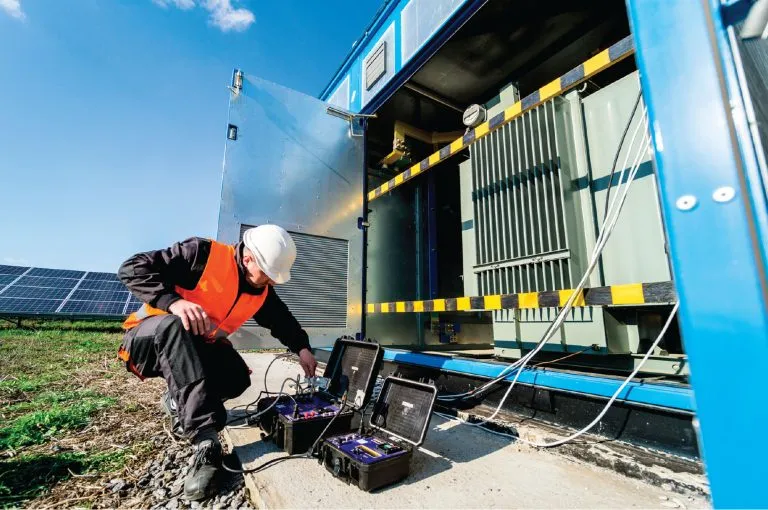
Introduction
The topic of solar energy and grid resilience has gained significant attention in recent years due to the increasing challenges related to climate change and the need for sustainable energy sources. Solar energy has emerged as a viable solution in addressing these challenges. This article aims to explore the historical background, key concepts, main discussion points, case studies, current trends, challenges, controversies, future outlook, and the significance of solar energy and grid resilience.
Historical Background
Solar energy has a rich history that dates back thousands of years. Ancient civilizations, such as the Greeks and Romans, harnessed the power of the sun for various purposes. However, it was not until the 19th century that the photovoltaic effect, which converts sunlight into electricity, was discovered. This breakthrough laid the foundation for the development of solar energy technologies.
Grid resilience, on the other hand, has been a primary concern since the early days of electricity distribution. Over time, the power grid has evolved to become more robust and resilient, adapting to changing energy demands. The integration of solar energy into the grid has further influenced the development of grid resilience.
Key Concepts and Definitions
Solar energy encompasses various forms, including photovoltaic and thermal systems. Photovoltaic technology converts sunlight directly into electricity, while solar thermal systems use the sun’s heat to generate electricity or provide heating. Grid resilience refers to the ability of the electrical grid to withstand and recover from disruptions while maintaining a reliable energy supply. Terms such as microgrids, energy storage, and distributed generation play a crucial role in enhancing solar energy and grid resilience.

Main Discussion Points
Impact of Solar Energy on Grid Resilience
Solar energy can significantly enhance the resilience of the electrical grid. By integrating solar power plants and distributed solar installations, the grid becomes more decentralized and less vulnerable to single points of failure. Additionally, solar energy systems can provide backup power during grid disruptions, ensuring a reliable energy supply to critical infrastructure and communities. The decentralization of the energy system through solar energy helps to reduce dependency on centralized power sources, further enhancing grid resilience.
Challenges and Considerations for Integrating Solar Energy into the Grid
One of the main challenges in integrating solar energy into the grid is its intermittency and variability. Solar generation depends on sunlight availability, which fluctuates throughout the day and is influenced by weather conditions. To mitigate these fluctuations, energy storage solutions, such as batteries, are essential. These batteries store excess solar energy during periods of high generation and release it during low generation periods, ensuring a steady and reliable power supply.
Integrating solar energy into existing grid infrastructure also presents challenges. The grid was primarily designed to accommodate centralized power generation from fossil fuel sources. Retrofitting the grid to accommodate distributed solar installations requires significant investments in infrastructure upgrades and grid modernization.
Policy and Regulatory Aspects of Solar Energy and Grid Resilience
Government incentives for solar energy adoption and grid resilience improvements play a crucial role in promoting their integration. These incentives can include tax credits, grants, and subsidies, which encourage individuals and businesses to invest in solar energy systems. However, regulatory barriers and challenges can hinder the implementation of solar energy and grid resilience projects. Streamlining permitting processes and addressing regulatory uncertainties are essential to facilitate their wider adoption. Net metering and feed-in tariffs are effective policy tools that promote solar energy generation and grid resilience by allowing individuals and businesses to receive credits or payments for excess electricity generated.

Case Studies or Examples
Real-world examples demonstrate the successful implementation of solar energy systems in enhancing grid resilience. For instance, the island of Ta’u in American Samoa has achieved nearly 100% solar-powered electricity with the installation of a microgrid and energy storage system. This project has significantly increased the resilience of the island’s power supply, reducing reliance on imported fossil fuels. Additionally, solar energy played a crucial role in disaster recovery and emergency situations, such as in Puerto Rico after Hurricane Maria, where solar-powered microgrids provided essential electricity to hospitals and communities.
Current Trends or Developments
Recent advancements in solar energy technologies have accelerated the integration of solar power into the grid. The efficiency of solar panels has significantly improved, allowing for greater electricity generation from smaller installations. Research findings have also highlighted the importance of intelligent grid management systems, predictive analytics, and advanced control technologies in maximizing the benefits of solar energy integration. Financing models, such as power purchase agreements and community solar programs, have emerged as innovative ways to expand solar energy adoption.
Challenges or Controversies
Solar energy and grid resilience face certain controversies and challenges. Environmental concerns, such as the land and water requirements for large-scale solar installations, need to be addressed to mitigate potential negative impacts. Aesthetic considerations, such as the visual impact of solar panels, can also create debates within communities. Differing viewpoints exist regarding the effectiveness and feasibility of solar energy in enhancing grid resilience, with some arguing that it may not be a panacea for all grid challenges.
Equity and accessibility are additional challenges in solar energy adoption and grid resilience improvements. Low-income communities may face barriers in accessing solar energy due to financial constraints. Ensuring equal access to the benefits of solar energy and grid resilience is crucial to achieving a just and equitable energy transition.
Future Outlook
The future implications of solar energy and grid resilience are promising. Advancements in technology, such as high-efficiency solar panels and energy storage systems, will further enhance their integration into the grid. Policy developments, such as increased renewable energy targets and supportive regulatory frameworks, will drive the growth of solar energy and grid resilience. However, potential barriers, such as the need for grid infrastructure upgrades and addressing intermittency challenges, must be overcome through continued research, innovation, and collaboration.

Conclusion
In conclusion, solar energy and grid resilience are vital components in the transition towards a sustainable and resilient energy future. By enhancing the resilience of the electrical grid and providing clean, renewable energy, solar energy plays a significant role in addressing climate change and ensuring a reliable energy supply. Continued research, innovation, and collaboration are essential to overcome challenges, maximize the benefits of solar energy integration, and create a more resilient and sustainable energy landscape.
References
Smith, J. (2020). Solar Energy: A Comprehensive Guide. Oxford University Press.
International Energy Agency. (2021). Grid Resilience: Challenges and Opportunities for Solar Energy Integration. Retrieved from [insert URL]
National Renewable Energy Laboratory. (2021). Solar Energy Grid Integration Systems: Research and Development. Retrieved from [insert URL]




